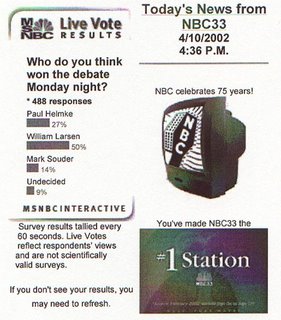ISTEP move
The ISTEP test will not be given in the spring instead of the fall. The politicians have now made it virtually impossible to identify how much our children are retaining. Test Scores will be higher and will translate into a higher percent improvement next year. However, this is a one time offset and has little substance if at all.
We have allowed our politicians to pass bad legislation once again. Are we afraid to look at the real problem behind low-test scores? We keep blaming it on low income, both spouses working, higher standards, Federal requirements and more, but are these really the problem?
I have five children and all learn differently and have different traits. The first problem I see is we have let statistics decide the course of action to take. Having worked with both out0of-control processes and in-control process, I understand the limits of statistics. The more consistent your raw material and parts, the more consistent your process will be. The more variability your raw material, the more variability you will have in your process. Our children are all different. At young ages, they are even more diverse than when they are older. Yet I see educators and politicians attempting to change education year after year in an attempt to get higher test scores.
Every change has pros and cons. Take for example full day kindergarten. Initially test scores are higher in grades up though third, but tend to be indistinguishable after grade five. Is it like a marathon where one runs faster for the first mile only to have everyone else catch-up in the second mile? Has anything been gained, no?
For any process to be fully evaluated, one must evaluate it based on a full cycle. In the case of education, the full cycle is thirteen years. I know of no study that has gone 13 years.
What I would like to see is:
- Less emphases on computers in grades K-8.
- More emphases on reading and basic math in grades K-5 and less emphases on currency, volume, measurement and other units of measure. Get the basics down first.
- Open up books that can be read outside of AR lists. 90% of the books I read as a kid are not on the AR list. The AR reading program is good for testing, but terrible in terms of getting kids interested in reading.
- Get back to writing book reports. If not then present a course on using computers, software and printers so that they are efficient at using them. I have yet to see any student in grade 7 and below able to type and use software without a parent's help and do it faster than hand writing. Learning is all about efficiency.
- Eliminate computer printed reports and require hand written reports. This will focus the student's attention on format and how to organize their thoughts to minimize erasing. Organizing and thought process are eliminated to a great extent using calculators and computers. It also will practice and improve handwriting.
- Get back to 55-minute classes. The brain begins to stop processing material after about one hour. This is why most companies when giving presentations take breaks on the hour.
- Less variety of high school courses. Get back to basics so that students know how to learn. High School is not a substitute or replacement for higher education. It is the foundation for higher education.



1 Comments:
Bill:
If I didn't know better, I'd swear you're from MY era of education...(the one that WORKED)...lol!
I'm with 'ya 100%!
;)
B.G.
Post a Comment
<< Home